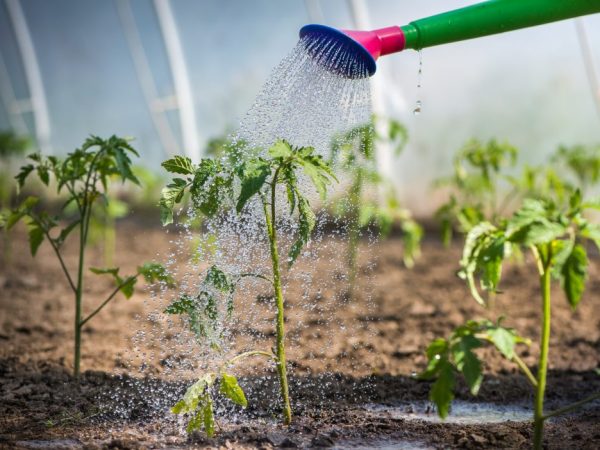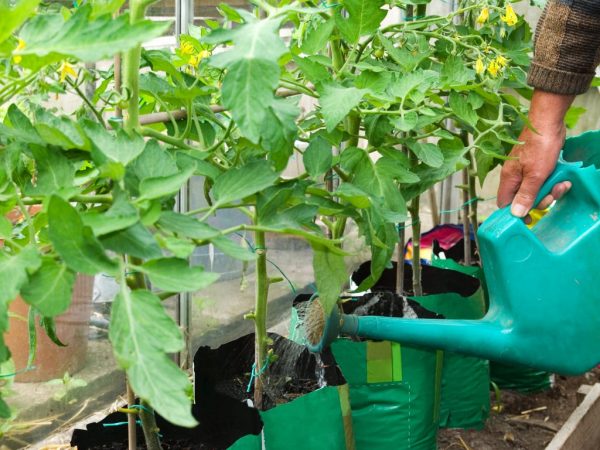Watering rules for tomato seedlings
Tomatoes are a thermophilic crop of intensive growth, the development of which depends on the observance of temperature and water regimes, the balance of essential substances in the soil. To get a good harvest, you need to know how to properly water tomato seedlings.

Watering rules for tomato seedlings
Water quality, frequency and timing of watering, nutritional supplements - all this is important for the full development of young plants.
Watering rules
The demands of tomatoes to moisten the soil is explained by the structure of their root system. The plant is nourished by the central taproot, which lengthens from 30-50 cm to 2 m as the bush grows, and numerous lateral roots. Thus, proper nutrition is carried out both at the expense of the upper layer of the earth, and at the expense of layers located at a considerable depth. Drying out of the soil prevents the absorption of nutrients, and waterlogging leads to a lack of oxygen, decay of roots, and the development of diseases.
How to properly water tomato seedlings at home, even before planting on the site:
- use rain (melt) or settled water;
- water with warm water (20-25 ° C);
- increase the rate of water consumption as the plants grow (seedlings - 1 liter, during the flowering period - 2 liters, during the formation of ovaries - 3-5 liters per plant);
- it is better to water rarely, but abundantly, than often and superficially;
- moistening the earth by spraying is permissible at the stage of seed germination or when the upper layers of the soil dry out during extreme heat;
- prevent moisture and dirt from getting on the leaves;
- the best time for watering is morning;
- the container in which the plantings grow must have drainage holes so that the water does not stagnate.
These are the most general guidelines. Watering requirements will differ at each stage of growing.
Watering features
For different stages of cultivation, a certain irrigation regime is characteristic.
Seedlings
Seeding of tomato seeds is carried out in moist soil at a shallow depth. To retain moisture, the tray is covered with glass or foil. The earth is moistened daily from a spray bottle, but excess moisture is not allowed.
With the emergence of friendly shoots, the film is removed and watering is stopped for 2-3 days so that the plants get stronger. Then the irrigation regime is changed: the sprouts are irrigated once a week; if the soil dries up quickly, then more often.
After the first true leaves appear, the need for water increases. Since the root system is actively developing, it is necessary to ensure uniform moisture in the soil layers. You can check the quality of watering in an opaque container using a wooden stick.
Picking
1-2 days before the dive, watering the seedlings is stopped so that the soil is moist, but loose. For the first 4-5 days, the dived bushes are not watered. The plants must be allowed to take root, and the soil must be moist enough to meet the water requirement of young tomatoes.
How often should dived tomato seedlings be watered? The frequency depends on the rate of drying of the soil (usually 1 time per week - 10 days). To stimulate the development of a powerful root system, it is recommended to water through a pan.
Landing in open ground

Water the plants as needed
Before planting tomato bushes in a permanent place in a greenhouse or on a garden bed, they are watered abundantly in 3-4 days. Thanks to this, the roots are not injured, the transfer of plants with an earthen clod ensures their faster adaptation.
The seedlings are not watered for a week: you need to let them take root in a new place. Further, the soil is moistened as necessary under the root, gradually increasing the rate. Frequent abundant watering creates favorable conditions for the development of fungal diseases: they reduce the temperature of the soil, promote stagnation of water. Tomatoes are fed every 10-14 days after watering.
Watering Nutrients
In order for the tomatoes to grow strong, the seedlings are watered with both industrially produced preparations and means from a home first-aid kit.
Kornevin
Kornevin contains phytohormones and trace elements that:
- contribute to the formation of a branched and strong root system;
- reduce transplant stress;
- increase the stability of seedlings in conditions of temperature and humidity changes.
The drug is used when diving and transplanting tomatoes into open ground. It is bred according to the instructions and used on the same day.
Seedlings with 2-3 true leaves are transplanted from trays into cups. This is done so that a small depression forms near the stem. After compaction of the earth, the seedling is watered with water, and then Kornevin. Formed wells will not allow you to exceed the dose.
In a similar way, the stimulant is used when planting seedlings in open ground. An overdose of the drug is harmful: it can slow down the development of plants.
A phytostimulant similar to Kornevin is prepared at home. To do this, cut thin willow branches into cuttings 20-25 cm long, place them in a tall dish and pour boiling water over them. After 48 hours of infusion, the drug is ready.
Since Kornevin belongs to substances of the III class of hazard, it is possible to work with him only using personal protective equipment.
Ammonia
An aqueous solution of ammonia (ammonia) is a drug that is in every home medicine cabinet. The high nitrogen content (more than 40% by weight), and in a form convenient for assimilation by plants, allows the use of ammonia for emergency assistance with nitrogen starvation of plants. Its advantages:
- cheapness;
- they cannot overfeed the plants, the excess will not accumulate;
- the alkaline reaction of the substance maintains the health of the soil (excess acid inhibits beneficial microorganisms).

The solution will help saturate the tomatoes with nitrogen.
Watering tomato seedlings is carried out with a weak solution of ammonia 2 weeks after the dive. For its preparation 2 tbsp. l. ammonia is diluted in 10 liters of water. Top dressing is applied after watering under the root with a weak stream. The procedure is repeated after 2 weeks.
A number of signs indicate a lack of nitrogen:
- the lower leaves turn yellow and shrink;
- the stem becomes thin and fragile;
- seedlings are stunted.
A solution of ammonia is also used for pest control. To destroy aphids, the bushes are treated. To scare off the bear, an ammonia solution is introduced into the hole before planting seedlings from pots.
Hydrogen peroxide
Fungal diseases are dangerous for tomato seedlings. Ogorodnikov worries about the best way to water tomato seedlings for the prevention and treatment of diseases.
Hydrogen peroxide has a bactericidal effect. Its solution is used for:
- destruction of pathogens, pests on plants and in the soil (due to oxidative action);
- aerating the soil (the solution is unstable, oxygen is released during decomposition);
- improving the quality of tap water (reacts with organic matter, pesticides).
Peroxide solution is successfully used for seed dressing. They are placed in a 10% solution for 20 minutes. To increase germination, immunity, they practice soaking the seeds before sowing for 12 hours. Then they are washed with water and dried to a free-flowing state. Soaking in peroxide solution can replace pickling with potassium permanganate.
The product is used for root hygiene. Rinsing with peroxide helps to eliminate rot, and spraying helps to eliminate phytophthora. The solution for late blight treatment is prepared in the following proportions: 1 tbsp. l. peroxide and 40 drops of iodine in a bucket of water. For watering tomato seedlings, 60 ml of hydrogen peroxide is dissolved in 3 liters of water.
This solution is also useful for caring for indoor plants.
Wood ash
Wood ash has long been considered a valuable fertilizer for garden crops.
It contains large amounts of potassium, calcium and phosphorus. Only the product of incineration of natural organic residues is used.
Ash fertilization allows tomatoes:
- build up green mass;
- resist fungal diseases;
- form ovaries in a timely manner.
Ash is used in the form of powder and liquid dressings. The scattered ash helps to fight slugs even at the first sign of blackleg (a common attack on tomatoes). Ash solution prepared from 1 tsp. fertilizer and 1 liter of water and aged for a day, used for seed dressing. After soaking in this solution for 5-6 hours, they germinate better.
Recommendations
- In order for the planted tomatoes to take root better, the bushes are strong, they need to be watered with ash. You can add dry ash when preparing the holes.
- Over-saturation of the soil with fertilizer will make potassium and phosphorus inaccessible to plants.
- An excellent alternative to fungicides to combat late blight is the treatment of tomatoes with kefir, milk (solution with the addition of iodine), and whey.
Conclusion
Proper care is the key to a good tomato harvest. The health and development of plants depends on timely and high-quality watering of tomato seedlings.


